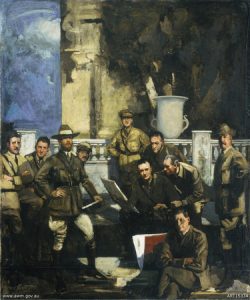George Washington Lambert
War Artist
By Major M.L.H Roberts
| Lambert’s war sketches have rarely been seen outside the Australian War Memorial, and within the Memorial itself, have been dominated by his larger paintings. Lambert had a close affinity with the Australian Light Horse and his works have in no small way contributed to the recording of its history. For those who have not had the opportunity to view the collection in the War Memorial, examples of his work and the story of his involvement follow. During 1980, a selection of Lambert’s war sketches and paintings were displayed by the National Gallery of Victoria. This was the first time since 1947 that selections from the Memorial’s collection of over 12,000 works have been displayed outside the Memorial. Further exhibitions are planned throughout Australia to make the pictorial recording of the nation’s military history more accessible to the community as a whole. In November 1917 Lambert was first approached by the Australian High Commissioner’s Office in London with an offer to proceed to the battle front to make pictorial records of Australians at war. Unable to enlist in the AIF outside Australia, despite a strong desire to do so, Lambert accepted the offer, swayed in no small degree by the theatre offered to him – Palestine. On Christmas Day 1917, complete with a Light Horseman’s plumed hat, spurs, leggings and honorary commission as a Lieutenant, he sailed for the Palestine front. He disembarked in Alexandria on 13 January 1918 and his progress northwards through Palestine can be traced from his prolific war sketches. Lambert had not been present during the early campaigning in Sinai and Palestine, but a prime requirement made of him by the Commander of the Desert Mounted Corps, Lieutenant General Sir Harry Chauvel, was that he should record the battlefields of Romani and Beersheba, two battles famous in the history of the Light Horse. These Lambert did in March 1918. In April 1918, Lambert returned to Cairo, his three month commission having expired. Hearing that the battle front was again active, he obtained approval to extend his duties by a visit to the Jordon Valley in May, where he completed further sketches. As an aside, his proposed method of returning his works to England is worthy of note. Prior to leaving Cairo, he carefully packed his sketches in waterproof containers linked by rope, which he proposed to take in tow lest the sea journey were to be abruptly ended in the Mediterranean by an enemy submarine. Lambert arrived back in London in June 1918, handing over to the Commonwealth more than 130 sketches, as well as his notebooks, in lieu of the twenty-five specified in his commission. The sketches include a series of pencil portraits of Light Horsemen and pencil studies of horses and men in action. In November 1918, Lambert joined a small “Australian Historical Mission” to visit Gallipoli to collect historical evidence and relics of the Allied expedition. This directly contributed to the historical accuracy of Lambert’s later paintings for the Australian War Memorial. Lambert’s commission for this mission was conditional on his returning to Palestine to make records of the Light Horse’s last push for Damascus. Twenty five paintings were completed on the Gallipoli Penisular. When Lambert returned to Palestine in May 1919, he went straight to Damascus; the Light Horse were demobilising. He visited Tiberias and the Jordan Valley tearing out pictures by the yard. Returning to Damascus he painted the Barada Gorge through which the Turks fled when the city fell, and at Moascar he recorded the demobilisation which was proceeding in blazing heat and “almost colourless light”. Lambert’s aim in accepting his commissions appears to have been to accomplish a lasting record of the Anzac and Palestine Operations. His sketches are the result of his taking great pains to accurately record the details of topography, colour, vegetation and military uniform and equipment. He achieved his aim. This is easily verified by comparing his sketches and paintings with the slides taken by the official war photographers of the same scenes that would have been observed by the artist. His works contribute in no small way to the preservation of our heritage – the Australian Light Horse. The nostalgic inscription on the back of Lambert’s last painting before returning to London in August 1919, of a scene of the pyramids, bears testimony to his feelings for the Light Horseman; “Au Souvenir” Specially Dedicated to the Light Horse AIF Egyptian Expeditionary Force.  Australian official war artists, 1916-1918 by George Coates, 1920. Oil on canvas, 124.2 x 104.5 cm. The group portrait includes the official War Artists; standing l-r: (Sir) John Longstaff, Charles Bryant, George Lambert, A. Henry Fullwood, James Quinn, Septimus Power, Arthur Streeton, seated back l-r: Will Dyson, Fred Leist, front: George Bell. Australian official war artists, 1916-1918 by George Coates, 1920. Oil on canvas, 124.2 x 104.5 cm. The group portrait includes the official War Artists; standing l-r: (Sir) John Longstaff, Charles Bryant, George Lambert, A. Henry Fullwood, James Quinn, Septimus Power, Arthur Streeton, seated back l-r: Will Dyson, Fred Leist, front: George Bell. |
